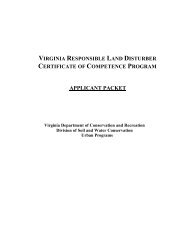Rare Animals - Virginia Department of Conservation and Recreation ...
Rare Animals - Virginia Department of Conservation and Recreation ...
Rare Animals - Virginia Department of Conservation and Recreation ...
Create successful ePaper yourself
Turn your PDF publications into a flip-book with our unique Google optimized e-Paper software.
LIST FORMAT<br />
The <strong>Rare</strong> Animal List is sorted by broad taxonomic groups <strong>and</strong> then ordered alphabetically by scientific name within<br />
each group. The list format consists <strong>of</strong> six fields: scientific name, common name, global rank, state rank, federal status,<br />
<strong>and</strong> state status. These fields are also used in the lists appearing in Appendices 1-5. To aid in the interpretation <strong>of</strong> the<br />
lists, a brief explanation <strong>of</strong> each field <strong>and</strong> a summary <strong>of</strong> abbreviations follow.<br />
Column 1. Scientific name:<br />
Nomenclature <strong>of</strong> animals is not contained in any single source. The most recent taxonomic sources are examined by the<br />
staff zoologist <strong>and</strong>, when necessary, direct consultations with experts are used to maintain the most scientifically accepted<br />
names for all animal groups. Divergences from these opinions are rare <strong>and</strong> generally occur only while an ongoing<br />
taxonomic study is being conducted. Contact the staff zoologist if you have questions or comments regarding the<br />
scientific names used herein.<br />
Column 2. Common name:<br />
A common name is provided for the convenience <strong>of</strong> the user. St<strong>and</strong>ard common names have been developed <strong>and</strong><br />
universally adopted for only a few animal groups; therefore, the user is cautioned to use scientific names whenever<br />
possible. The common names for most vertebrates <strong>and</strong> a few selected aquatic invertebrate groups (e.g., mussels) are<br />
recognized as stable. Most invertebrate species lack common names <strong>and</strong> it may not be practical to provide such names.<br />
They are usually indicated in the list as “a caddisfly”, “a millipede”, etc. The primary sources <strong>of</strong> common names applied<br />
to species in selected groups included in this list can be found on page 6. Many other common names that appear in the<br />
list, especially those <strong>of</strong> invertebrates, are not widely used or universally accepted.<br />
Column 3. Global rank:<br />
Global ranks are assigned by a consensus <strong>of</strong> the network <strong>of</strong> natural heritage programs, scientific experts, <strong>and</strong> NatureServe<br />
(a non-pr<strong>of</strong>it conservation organization) to designate the rangewide rarity <strong>of</strong> a species or subspecies. This system was<br />
originally developed by The Nature Conservancy <strong>and</strong> is widely used by other agencies (e.g., U.S. Fish <strong>and</strong> Wildlife<br />
Service, U.S. Forest Service) <strong>and</strong> organizations as the best available scientific <strong>and</strong> objective assessment <strong>of</strong> an animal’s<br />
rarity <strong>and</strong> the level <strong>of</strong> threat to its existence. The ranks are assigned after considering a suite <strong>of</strong> factors including the<br />
number <strong>of</strong> occurrences (populations), number <strong>of</strong> individuals, <strong>and</strong> severity <strong>of</strong> threats to the species <strong>and</strong> its habitats. Global<br />
ranks found in the <strong>Rare</strong> Animal List are explained below:<br />
G1 Extremely rare <strong>and</strong> critically imperiled with 5 or fewer occurrences or very few remaining individuals;<br />
or because <strong>of</strong> some factor(s) making it especially vulnerable to extinction.<br />
G2 Very rare <strong>and</strong> imperiled with 6 to 20 occurrences or few remaining individuals; or because <strong>of</strong> some factor(s)<br />
making it vulnerable to extinction.<br />
G3 Either very rare <strong>and</strong> local throughout its range or found locally (even abundantly at some <strong>of</strong> its locations) in<br />
a restricted range; or vulnerable to extinction because <strong>of</strong> other factors. Usually fewer than 100 occurrences<br />
are documented.<br />
G4 Common <strong>and</strong> apparently secure globally, although it may be rare in parts <strong>of</strong> its range, especially at the<br />
periphery.<br />
G5 Very common <strong>and</strong> demonstrably secure globally, although it may be rare in parts <strong>of</strong> its range, especially at<br />
the periphery.<br />
GH Formerly part <strong>of</strong> the world’s fauna with some expectation that it may be rediscovered; generally applies to<br />
species that have not been verified for an extended period (usually >15 years) <strong>and</strong> for which some inventory<br />
has been attempted recently.<br />
GX Believed to be extinct throughout its range with virtually no likelihood <strong>of</strong> rediscovery.<br />
2
















